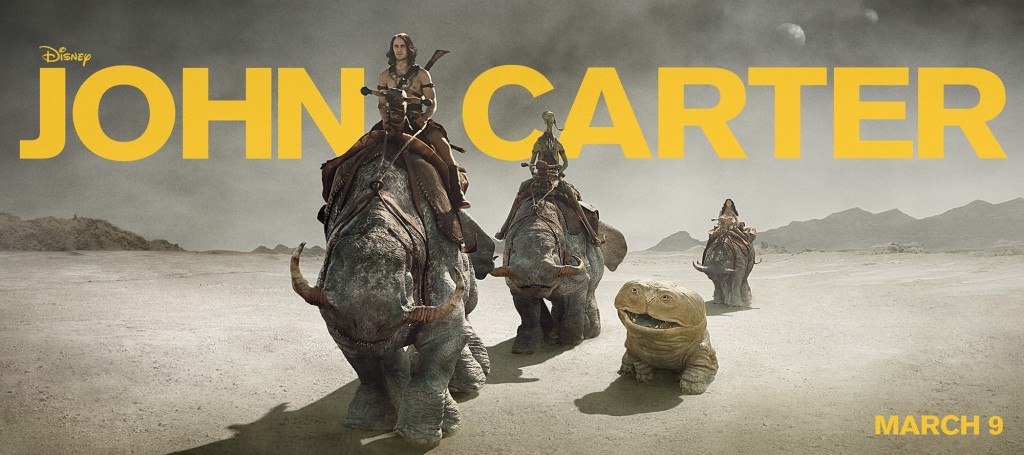 One year ago today, John Carter made its theatrical debut. Fans of this ambitious, intelligent, visually stunning, and thoroughly exciting sci-fi epic haven’t had the easiest year. Just a few weeks ago, prior to the Academy Awards, when I mentioned at the office that, at the very least, composer Michael Giacchino should’ve gotten an Oscar nod for his score, co-workers greeted the idea with laughter.
One year ago today, John Carter made its theatrical debut. Fans of this ambitious, intelligent, visually stunning, and thoroughly exciting sci-fi epic haven’t had the easiest year. Just a few weeks ago, prior to the Academy Awards, when I mentioned at the office that, at the very least, composer Michael Giacchino should’ve gotten an Oscar nod for his score, co-workers greeted the idea with laughter.
Plenty of people remain unwilling to judge John Carter on its merits—a shame, because those merits are so many. For those who’ve pledged their metal to this unfairly maligned motion picture, however, there’s no shortage of reasons to stop championing it.
Here are a baker’s dozen—one for each month of a year (and one extra for reasons of collegiate pride).
January – Michael Giacchino’s Score
 All right, I admit up front: some of these month-topic pairings are more of a stretch than others, and this one definitely involves some reaching. But you could do worse than to make a New Year’s resolution to listen to Michael Giacchino’s John Carter score. (At least I warned you!) Giacchino’s music is magnificent, and I’ve lost track of how many times I’ve listened to this rich orchestral masterpiece. It’s hard to choose a favorite track from the album, but I guess I’d pick the humorously named but serious and soaring “Carter They Come, Carter They Fall,” which joins a brief burst of pounding action music with a heart-rending statement of the film’s love theme (you can see the finished scene below). I also enjoy the playful variations on the main theme that occur in “Get Carter” (where it is played a la The Magnificent Seven) and “Gravity of the Situation” (where its rises and falls, perfectly illustrating in sound Carter’s struggle to gain his footing on Mars). The entire score, however, succeeds brilliantly. FilmScore ClickTrack called it “quite simply breathtaking, a thrilling throwback to heroic film scores of yore.”
All right, I admit up front: some of these month-topic pairings are more of a stretch than others, and this one definitely involves some reaching. But you could do worse than to make a New Year’s resolution to listen to Michael Giacchino’s John Carter score. (At least I warned you!) Giacchino’s music is magnificent, and I’ve lost track of how many times I’ve listened to this rich orchestral masterpiece. It’s hard to choose a favorite track from the album, but I guess I’d pick the humorously named but serious and soaring “Carter They Come, Carter They Fall,” which joins a brief burst of pounding action music with a heart-rending statement of the film’s love theme (you can see the finished scene below). I also enjoy the playful variations on the main theme that occur in “Get Carter” (where it is played a la The Magnificent Seven) and “Gravity of the Situation” (where its rises and falls, perfectly illustrating in sound Carter’s struggle to gain his footing on Mars). The entire score, however, succeeds brilliantly. FilmScore ClickTrack called it “quite simply breathtaking, a thrilling throwback to heroic film scores of yore.”
February – Dejah Thoris
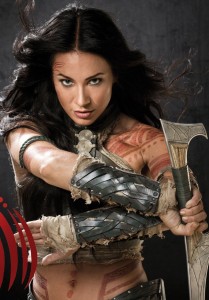 Disney’s “marketing” of John Carter (using that word generously) failed to mention that the movie is, at its heart, a love story. On a John Carter calendar, then, how could February, the month that brings us Valentine’s Day, celebrate anyone but the incomparable Dejah Thoris? Lynn Collins portrays a different kind of “Disney Princess”: she is not only beautiful but also an accomplished scientist as well as a skilled pilot and sword-wielder. Intelligent, determined, and not above tweaking John Carter’s genteel Southern sensibilities with a glint in her eye and mischievous smile (“If you’ll just stand behind me, sir….!”), Collins’ Dejah escapes the “eye candy” status to which the character is consigned in Frank Frazetta paintings and on Dynamite comic book covers to emerge as a powerful, passionate woman. She is no “prize,” as Matai Shang reminds Sab Than (albeit for different reasons), but it’s easy to see why Carter prizes his life on Barsoom with her.
Disney’s “marketing” of John Carter (using that word generously) failed to mention that the movie is, at its heart, a love story. On a John Carter calendar, then, how could February, the month that brings us Valentine’s Day, celebrate anyone but the incomparable Dejah Thoris? Lynn Collins portrays a different kind of “Disney Princess”: she is not only beautiful but also an accomplished scientist as well as a skilled pilot and sword-wielder. Intelligent, determined, and not above tweaking John Carter’s genteel Southern sensibilities with a glint in her eye and mischievous smile (“If you’ll just stand behind me, sir….!”), Collins’ Dejah escapes the “eye candy” status to which the character is consigned in Frank Frazetta paintings and on Dynamite comic book covers to emerge as a powerful, passionate woman. She is no “prize,” as Matai Shang reminds Sab Than (albeit for different reasons), but it’s easy to see why Carter prizes his life on Barsoom with her.
March – Those Magnificent Flying Machines
As I said in my review last year, the real star of John Carter is the world of Barsoom. Director Andrew Stanton and his creative team worked long and hard to bring Edgar Rice Burroughs’ richly imagined world to the screen, including its vehicles. What better way would there be to enjoy the first stirrings of springtime’s warm air and bright sunshine than to soar through the skies in a Barsoomian airship? (Yes, another stretch—mea culpa). I’d love to be a passenger on one of Helium’s massive cruisers, powered by sunlight, its blue banners proudly waving (Zodanga has airships, too, of course, but they don’t fare as well in this film!). Or, in a more daring moment, I might even try operating a one-person flyer—sure, they reminded me of the speeder bikes in Return of the Jedi, too, but remember that Edgar Rice Burroughs had the idea first!
April – Zodanga
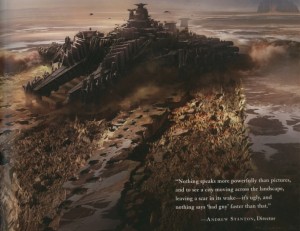 April 22 is Earth Day on our planet. I don’t know if Barsoomian society observes any equivalent, but there’s little doubt Martians should have been paying more attention to the environment of their dying planet. The marching city of Zodanga (a deviation from Burroughs’ texts, but a visually arresting one) symbolizes all the worst ways in which we human beings misinterpret or outright ignore God’s command to exercise “dominion” over the environment (Genesis 1.26). Dominion does not mean domination; it means taking our cue from how God rules, with care that nurtures and encourages life to flourish. Every time it plunges one of its massive “feet” into the Martian soil, however, leaving a long and wide path of destruction in its wake, Zodanga violates its environment as we so often do ours, taking the resources we need or want with no thought for the consequences. John Carter’s environmental theme is not overpowering, but it is present, and we’d do well to pay attention.
April 22 is Earth Day on our planet. I don’t know if Barsoomian society observes any equivalent, but there’s little doubt Martians should have been paying more attention to the environment of their dying planet. The marching city of Zodanga (a deviation from Burroughs’ texts, but a visually arresting one) symbolizes all the worst ways in which we human beings misinterpret or outright ignore God’s command to exercise “dominion” over the environment (Genesis 1.26). Dominion does not mean domination; it means taking our cue from how God rules, with care that nurtures and encourages life to flourish. Every time it plunges one of its massive “feet” into the Martian soil, however, leaving a long and wide path of destruction in its wake, Zodanga violates its environment as we so often do ours, taking the resources we need or want with no thought for the consequences. John Carter’s environmental theme is not overpowering, but it is present, and we’d do well to pay attention.
May – The screenplay
Michael Chabon celebrates his birthday on May 24, and this Pulitzer Prize-winning author of The Adventures of Kavalier and Clay received a writing credit for an early draft of the John Carter script. I don’t know how many of his contributions appear in the final version, but I do know this movie boasts one of the best action-adventure scripts in recent memory. Last year, Chabon told The Telegraph, “I think Hollywood used to be good at making intelligent adventure movies… Hollywood did it for decades and got very good at it, and it’s sort of a faded skill now. I think Andrew [Stanton] has revived it with this film.” John Carter’s screenplay (for which Stanton and Mark Andrews also receive credit) is unafraid to treat its audience as smart, as capable of paying attention. Nothing about this script was done shoddily or half-heartedly: not the frame story involving a young Ned Burroughs, not the incorporation of Burroughs’ intricate and evocative Barsoomian mythology, not even such “grace notes” as Tars Tarkas’ wonderful biblical allusion, “My right arms offend me; I will cut them off!” John Carter’s script was as lovingly crafted as the rest of the film.
June – Tars Tarkas
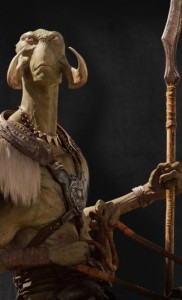 Speaking of the jeddak of the Tharks, Tars Tarkas is not only a fierce warrior and inspiring leader but also a father, making the month that includes Father’s Day the perfect time to consider this complex character. One of the movie’s joys is seeing Tars and Sola, his oft-punished daughter, set free, through Carter’s intervention, to establish a parent-child relationship with each other in defiance of Thark custom. Thanks to Willem Dafoe’s remarkable performance, enhanced by computer animation—and it is enhancement, since Dafoe is doing more than providing voice talent; as the actor told a reporter last year, “Voiced schmoiced! I did that! I was up on stilts in the middle of the desert!”—we see the moving and memorable arc of a man (albeit a green, nine-foot-tall, four-armed, tusked man) learning how to connect with his family.
Speaking of the jeddak of the Tharks, Tars Tarkas is not only a fierce warrior and inspiring leader but also a father, making the month that includes Father’s Day the perfect time to consider this complex character. One of the movie’s joys is seeing Tars and Sola, his oft-punished daughter, set free, through Carter’s intervention, to establish a parent-child relationship with each other in defiance of Thark custom. Thanks to Willem Dafoe’s remarkable performance, enhanced by computer animation—and it is enhancement, since Dafoe is doing more than providing voice talent; as the actor told a reporter last year, “Voiced schmoiced! I did that! I was up on stilts in the middle of the desert!”—we see the moving and memorable arc of a man (albeit a green, nine-foot-tall, four-armed, tusked man) learning how to connect with his family.
July – The Temple of Issus
(All right, time to stretch again…) July is the height of summer vacation, right? Well, John Carter, Dejah Thoris, and Sola don’t exactly go on vacation, but they do take a trip during the movie, down the River Iss in search of the Gates of Issus, where Dejah tells John he can learn how to return to Jasoom (that’s Earth to Terrans like us). The “revelation” (driven by alien technology that, true to Clarke’s Third Law, seems like magic) they receive inside the awe-inspiring Temple of Issus is one of the scenes that most excites my sense of wonder, even after repeated viewings. I’d love to schedule a summer vacation to this Temple (although making and sending a quantum copy of myself to Mars is more than my travel budget allows). Incidentally, of interest to sci-fi Christians: the Temple is where Dejah realizes that John is telling the truth about himself. Previously, she had been convinced that he must either be a lunatic or a liar. Fans of C.S. Lewis will recognize the theological parallel without too much trouble!
August – Woola!
Not only are we now well into the “dog days” of summer, but it turns out August 26 is National Dog Day. I will adm it I am not much of a dog-lover in real life (flame me not), but I think Woola, the “nice monster dog” (as Carter calls him at their first meeting), is wonderful! Straight from the pages of Burroughs’ books, Woola is impossibly speedy for a creature of his bulk (well, some Barsoom experts out there have probably figured out how to fudge the physics of his movement), but the love and loyalty he slobbers on Carter make him easily the most endearing science fictional pet since K-9. When Woola stands his ground as the Warhoon bear down on Carter, even though Carter is urging the animal to run away, the audience I first saw the film with actually cheered!
it I am not much of a dog-lover in real life (flame me not), but I think Woola, the “nice monster dog” (as Carter calls him at their first meeting), is wonderful! Straight from the pages of Burroughs’ books, Woola is impossibly speedy for a creature of his bulk (well, some Barsoom experts out there have probably figured out how to fudge the physics of his movement), but the love and loyalty he slobbers on Carter make him easily the most endearing science fictional pet since K-9. When Woola stands his ground as the Warhoon bear down on Carter, even though Carter is urging the animal to run away, the audience I first saw the film with actually cheered!
Here was another scene that garnered a great response (you get to see both Woola and those awesome flying machines I mentioned ealier):
September – Ned Burroughs
 Born on September 1, 1875, Edgar Rice Burroughs wrote his first story for publication—then titled Under the Moons of Mars, later A Princess of Mars, the first tale of Barsoom—in 1912 under the nom de plume “Normal Bean.” I don’t know whether anyone actually called him “Ned,” but that’s the name he goes by in John Carter. Including Burroughs as a character in the film follows the novel’s lead: the narrator frames “Captain Carter’s strange manuscript” for the reader, just as, in the film, we “read” Carter’s journal through Ned’s wondering eyes. What’s more, however, Ned (sympathetically played by Daryl Sabara) becomes our surrogate at the film’s end, when the “resurrected” Carter gives him this commission: “Take up a cause. Fall in love. Write a book.” Not bad advice: connect to and communicate with the world outside oneself. Listening in awe to the stories of others is well and good, but we must not let it keep us from living out the unique story of our own lives, rejoicing in the gift that they are (and thereby glorifying our Author).
Born on September 1, 1875, Edgar Rice Burroughs wrote his first story for publication—then titled Under the Moons of Mars, later A Princess of Mars, the first tale of Barsoom—in 1912 under the nom de plume “Normal Bean.” I don’t know whether anyone actually called him “Ned,” but that’s the name he goes by in John Carter. Including Burroughs as a character in the film follows the novel’s lead: the narrator frames “Captain Carter’s strange manuscript” for the reader, just as, in the film, we “read” Carter’s journal through Ned’s wondering eyes. What’s more, however, Ned (sympathetically played by Daryl Sabara) becomes our surrogate at the film’s end, when the “resurrected” Carter gives him this commission: “Take up a cause. Fall in love. Write a book.” Not bad advice: connect to and communicate with the world outside oneself. Listening in awe to the stories of others is well and good, but we must not let it keep us from living out the unique story of our own lives, rejoicing in the gift that they are (and thereby glorifying our Author).
October – The Therns
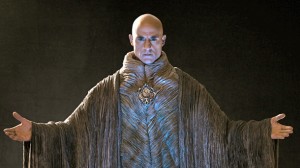 As Halloween approaches and we consider what disguises we might don for trick-or-treating, how can we help but think of the “holy”—by which, of course, we here mean sinister and creepy—Therns, the shadowy, behind-the-scenes villains of John Carter? In giving Sab Than a Ninth Ray weapon, they upset the balance of power on Barsoom, not for the sake of Zodanga, but for their own. As Matai Shang (played by Mark Strong) tells Carter, “We do not cause the destruction of a world… We simply manage it. Feed off it, if you like.” In many ways, this fact makes the Therns more villainous: they aggravate and take advantage of others’ conflicts and failures. They are parasites, incapable of making any positive contributions, merely siphoning what they need from war and disaster. Pretty scary stuff, indeed! Their sinister nature is doubly worse because they have established themselves as the gods of Mars—a reminder that anyone who uses religion as a license to satisfy themselves at others’ expense is wearing a mask, and is not to be trusted (even if they don’t manipulate crazy blue energy).
As Halloween approaches and we consider what disguises we might don for trick-or-treating, how can we help but think of the “holy”—by which, of course, we here mean sinister and creepy—Therns, the shadowy, behind-the-scenes villains of John Carter? In giving Sab Than a Ninth Ray weapon, they upset the balance of power on Barsoom, not for the sake of Zodanga, but for their own. As Matai Shang (played by Mark Strong) tells Carter, “We do not cause the destruction of a world… We simply manage it. Feed off it, if you like.” In many ways, this fact makes the Therns more villainous: they aggravate and take advantage of others’ conflicts and failures. They are parasites, incapable of making any positive contributions, merely siphoning what they need from war and disaster. Pretty scary stuff, indeed! Their sinister nature is doubly worse because they have established themselves as the gods of Mars—a reminder that anyone who uses religion as a license to satisfy themselves at others’ expense is wearing a mask, and is not to be trusted (even if they don’t manipulate crazy blue energy).
November – Kantos Kan
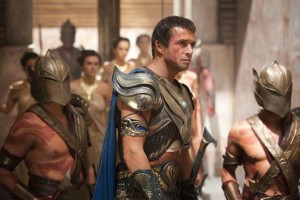 I initially resented James Purefoy’s brief performance as Kantos Kan, general of Helium, simply because so many movie critics were pointing to him as the only fun thing about the film! Having watched John Carter several times now, however, I gladly grant that, while far from the only good thing about the movie, Purefoy is one of its many highlights—and I’m thankful for that, just as Dejah Thoris gives him thanks for retrieving John Carter for her. (And November’s a good month for giving thanks… are your muscles tired of stretching yet?) Kantos isn’t on screen for long, but he’s got some great lines, including this impression of a Barsoomian Garrison Keillor: “Ah, Zodanga, where the men are as limited as the menu and woman are as hard as the beds.” Ouch!
I initially resented James Purefoy’s brief performance as Kantos Kan, general of Helium, simply because so many movie critics were pointing to him as the only fun thing about the film! Having watched John Carter several times now, however, I gladly grant that, while far from the only good thing about the movie, Purefoy is one of its many highlights—and I’m thankful for that, just as Dejah Thoris gives him thanks for retrieving John Carter for her. (And November’s a good month for giving thanks… are your muscles tired of stretching yet?) Kantos isn’t on screen for long, but he’s got some great lines, including this impression of a Barsoomian Garrison Keillor: “Ah, Zodanga, where the men are as limited as the menu and woman are as hard as the beds.” Ouch!
December – John Carter himself
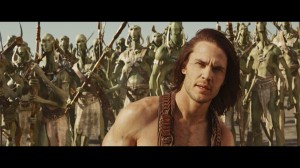 Others more clever than I have noted parallels between this film’s protagonist and Jesus (even down to their shared initials!). I don’t know that I’d call John Carter (played by Taylor Kitsch) a Christ-figure per se, but I will say that Tars Tarkas’ reaction to Carter’s arrival on Barsoom puts me in mind of the Incarnation, the great truth that Christians celebrate each December 25. Tars tells Carter, “When I saw you, I believed it was a sign that something new can come into this world.” Tars’ words make me think of words from the Gospel of John, words that tell us that Jesus was both something new and something old, very old—from “the beginning,” in fact—coming into our world, to save it. “The true light, which enlightens everyone, was coming into the world,” yet the world did not know him. Many of his own people did not receive him. But to those who did, “who believed in his name, he gave power to become children of God” (see John 1:1-14, especially vv. 9-12). John Carter is not Jesus; but his entrance into Barsoom may serve as a parable, albeit a limited one, of how Jesus entered our world, to lead us to freedom—spiritual, enteral freedom, to be sure, but also a new way of life that cannot help but change how we live in the physical, temporal world, and which leads us to seek freedom for others.
Others more clever than I have noted parallels between this film’s protagonist and Jesus (even down to their shared initials!). I don’t know that I’d call John Carter (played by Taylor Kitsch) a Christ-figure per se, but I will say that Tars Tarkas’ reaction to Carter’s arrival on Barsoom puts me in mind of the Incarnation, the great truth that Christians celebrate each December 25. Tars tells Carter, “When I saw you, I believed it was a sign that something new can come into this world.” Tars’ words make me think of words from the Gospel of John, words that tell us that Jesus was both something new and something old, very old—from “the beginning,” in fact—coming into our world, to save it. “The true light, which enlightens everyone, was coming into the world,” yet the world did not know him. Many of his own people did not receive him. But to those who did, “who believed in his name, he gave power to become children of God” (see John 1:1-14, especially vv. 9-12). John Carter is not Jesus; but his entrance into Barsoom may serve as a parable, albeit a limited one, of how Jesus entered our world, to lead us to freedom—spiritual, enteral freedom, to be sure, but also a new way of life that cannot help but change how we live in the physical, temporal world, and which leads us to seek freedom for others.
“That don’t look like a fair fight,” Carter says, when he sees the airships of Zodanga pursuing those of Helium. And, in our world, the victims of injustice and evil do not face a fair fight. May the Holy Spirit motivate and empower us, each month of every year, and every day of our lives, to leap into action on their behalf, confident in God’s power and grace, so that (with apologies to Tars Tarkas and even more reverent ones to Jesus in Matthew 5.16) others may see our good works, give glory to our Father in heaven, and someday say, “Did I not tell you he could jump!”
BONUS: Next time you watch John Carter, pay special attention to the telegraph station referenced at the top right of the message Ned Burroughs receives. The message was apparently relayed through the College of William and Mary—this author’s alma mater (class of ’94). Go Tribe! Hark upon the Gale!

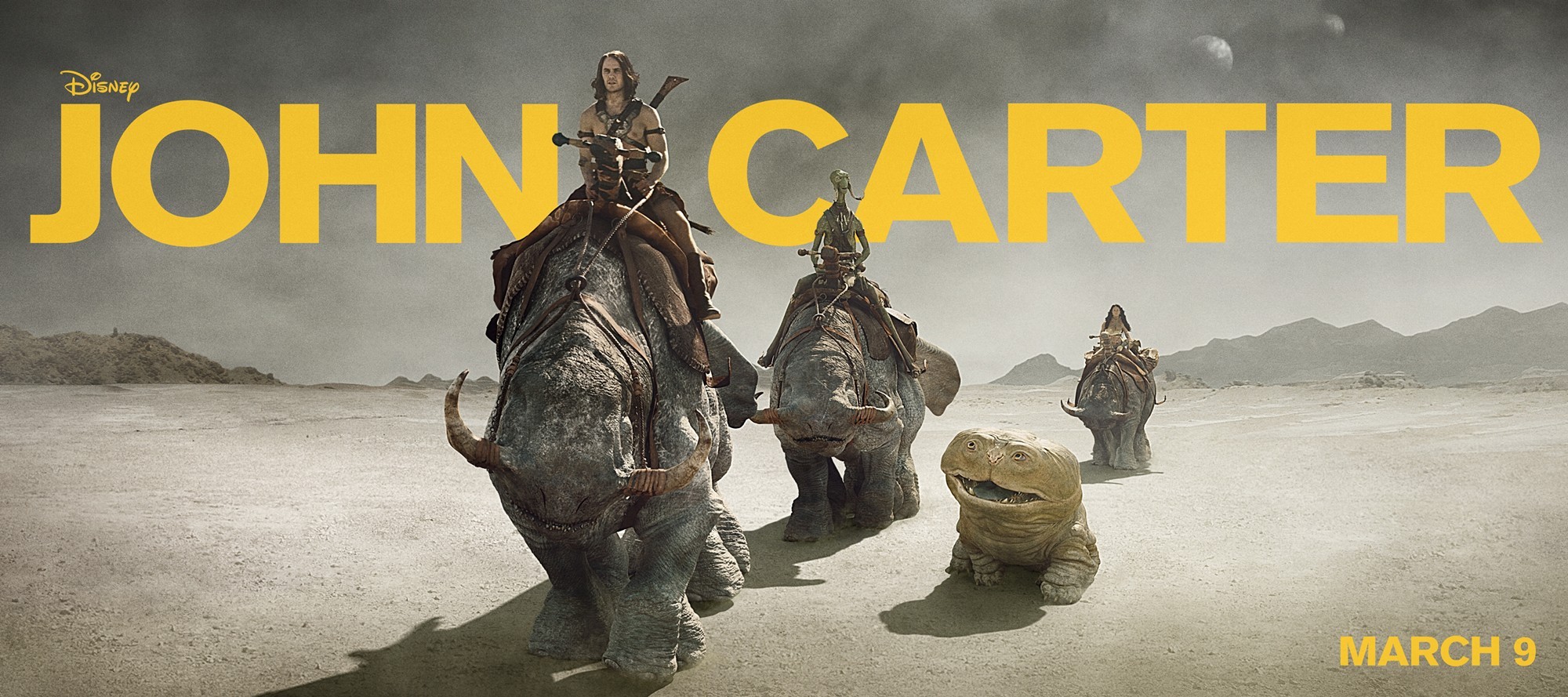
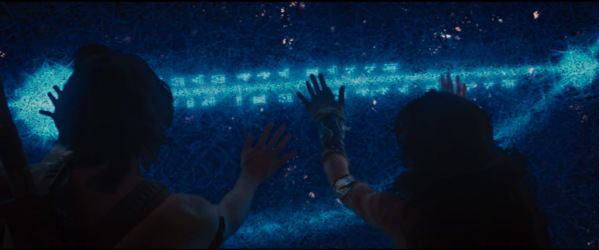
If I could have changed anything, I really wanted some more Kantos Kan!
Wow, I just cannot believe it’s been a year!